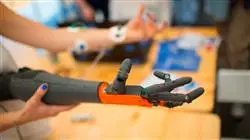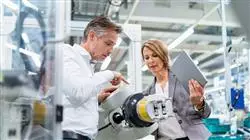University certificate
The world's largest faculty of engineering”
Introduction to the Program
Thanks to this Postgraduate diploma you will master the methods of transmission and transformation of mechanical motion and all in a convenient 100% online format"

Mechatronics Engineering has become an indispensable aspect for institutions. This is due to its interdisciplinary character: it fosters innovation in Mechanics, Computer Science and Electronics. To this end, it focuses on analyzing aspects such as the different sensors, the operation of manufacturing processes and the use of industrial machines. The truth is that, as industry moves towards the era of intelligent manufacturing, this field is consolidating, allowing better efficiency goals to be achieved.
In view of this, TECH has devised a study program that delves into the different components that regulate the operation of a machine or mechatronic system. Specifically, the program covers different types of sensors (presence, position, temperature and physical variables), as well as actuators (electric, pneumatic and hydraulic). In turn, it delves into those bearings, springs and connecting elements that are indispensable, paying special attention to the criteria for their selection and application in specific equipment.
Next, the academic itinerary describes the basics of automation required in this branch of engineering. Through its academic modules, emphasis is placed on PLC programming, continuous controls by means of regulators, axes, among others. Finally, students are provided with a comprehensive analysis of how these complex machines are inserted in industries and how to ensure their safe implementation.
To consolidate the mastery of all these contents, the Postgraduate diploma applies the innovative Relearningsystem. TECH is a pioneer in the use of this teaching model that promotes the assimilation of complex concepts through the natural and progressive reiteration of them. Also, the program is nourished by materials in various formats such as explanatory videos and infographics. All this in a convenient 100% online modality that allows adjusting the schedules of each person to their responsibilities and availability.
Access the cutting-edge content of this program through multimedia resources such as how-to videos and interactive overviews and interactive summaries"
This Postgraduate diploma in Mechatronics Engineering contains the most complete and up-to-date program on the market. Its most notable features are:
- The development of case studies presented by experts in Mechatronics Engineering.
- The graphic, schematic and practical contents with which it is conceived provide cutting- Therapeutics and practical information on those disciplines that are essential for professional practice.
- Practical exercises where the self-assessment process can be carried out to improve learning
- Its special emphasis on innovative methodologies
- Theoretical lessons, questions to the expert, debate forums on controversial topics, and individual reflection assignments
- Content that is accessible from any fixed or portable device with an Internet connection
With TECH you will master integrated manufacturing systems and overcome the challenges of Industry 4.0"
The program’s teaching staff includes professionals from the field who contribute their work experience to this educational program, as well as renowned specialists from leading societies and prestigious universities.
The multimedia content, developed with the latest educational technology, will provide the professional with situated and contextual learning, i.e., a simulated environment that will provide immersive education programmed to learn in real situations.
This program is designed around Problem-Based Learning, whereby the professional must try to solve the different professional practice situations that arise during the academic year For this purpose, the students will be assisted by an innovative interactive video system created by renowned and experienced experts.
Thanks to this 100% online TECH course, you will delve into the development of intelligent processes that facilitate human activities"

You will acquire advanced competencies in a comfortable and flexible way, without rigid schedules or pre-established evaluation chronograms"
Why study at TECH?
TECH is the world’s largest online university. With an impressive catalog of more than 14,000 university programs available in 11 languages, it is positioned as a leader in employability, with a 99% job placement rate. In addition, it relies on an enormous faculty of more than 6,000 professors of the highest international renown.

Study at the world's largest online university and guarantee your professional success. The future starts at TECH”
The world’s best online university according to FORBES
The prestigious Forbes magazine, specialized in business and finance, has highlighted TECH as “the world's best online university” This is what they have recently stated in an article in their digital edition in which they echo the success story of this institution, “thanks to the academic offer it provides, the selection of its teaching staff, and an innovative learning method aimed at educating the professionals of the future”
A revolutionary study method, a cutting-edge faculty and a practical focus: the key to TECH's success.
The most complete study plans on the university scene
TECH offers the most complete study plans on the university scene, with syllabuses that cover fundamental concepts and, at the same time, the main scientific advances in their specific scientific areas. In addition, these programs are continuously being updated to guarantee students the academic vanguard and the most in-demand professional skills. In this way, the university's qualifications provide its graduates with a significant advantage to propel their careers to success.
TECH offers the most comprehensive and intensive study plans on the current university scene.
A world-class teaching staff
TECH's teaching staff is made up of more than 6,000 professors with the highest international recognition. Professors, researchers and top executives of multinational companies, including Isaiah Covington, performance coach of the Boston Celtics; Magda Romanska, principal investigator at Harvard MetaLAB; Ignacio Wistumba, chairman of the department of translational molecular pathology at MD Anderson Cancer Center; and D.W. Pine, creative director of TIME magazine, among others.
Internationally renowned experts, specialized in different branches of Health, Technology, Communication and Business, form part of the TECH faculty.
A unique learning method
TECH is the first university to use Relearning in all its programs. It is the best online learning methodology, accredited with international teaching quality certifications, provided by prestigious educational agencies. In addition, this disruptive educational model is complemented with the “Case Method”, thereby setting up a unique online teaching strategy. Innovative teaching resources are also implemented, including detailed videos, infographics and interactive summaries.
TECH combines Relearning and the Case Method in all its university programs to guarantee excellent theoretical and practical learning, studying whenever and wherever you want.
The world's largest online university
TECH is the world’s largest online university. We are the largest educational institution, with the best and widest online educational catalog, one hundred percent online and covering the vast majority of areas of knowledge. We offer a large selection of our own degrees and accredited online undergraduate and postgraduate degrees. In total, more than 14,000 university degrees, in eleven different languages, make us the largest educational largest in the world.
TECH has the world's most extensive catalog of academic and official programs, available in more than 11 languages.
Google Premier Partner
The American technology giant has awarded TECH the Google Google Premier Partner badge. This award, which is only available to 3% of the world's companies, highlights the efficient, flexible and tailored experience that this university provides to students. The recognition as a Google Premier Partner not only accredits the maximum rigor, performance and investment in TECH's digital infrastructures, but also places this university as one of the world's leading technology companies.
Google has positioned TECH in the top 3% of the world's most important technology companies by awarding it its Google Premier Partner badge.
The official online university of the NBA
TECH is the official online university of the NBA. Thanks to our agreement with the biggest league in basketball, we offer our students exclusive university programs, as well as a wide variety of educational resources focused on the business of the league and other areas of the sports industry. Each program is made up of a uniquely designed syllabus and features exceptional guest hosts: professionals with a distinguished sports background who will offer their expertise on the most relevant topics.
TECH has been selected by the NBA, the world's top basketball league, as its official online university.
The top-rated university by its students
Students have positioned TECH as the world's top-rated university on the main review websites, with a highest rating of 4.9 out of 5, obtained from more than 1,000 reviews. These results consolidate TECH as the benchmark university institution at an international level, reflecting the excellence and positive impact of its educational model.” reflecting the excellence and positive impact of its educational model.”
TECH is the world’s top-rated university by its students.
Leaders in employability
TECH has managed to become the leading university in employability. 99% of its students obtain jobs in the academic field they have studied, within one year of completing any of the university's programs. A similar number achieve immediate career enhancement. All this thanks to a study methodology that bases its effectiveness on the acquisition of practical skills, which are absolutely necessary for professional development.
99% of TECH graduates find a job within a year of completing their studies.
Postgraduate Diploma in Mechatronics Engineering
In a constantly evolving world, mechatronics engineering has become an essential field for technological development and innovation. TECH Global University presents you with the Postgraduate Diploma in Mechatronics Engineering, a program designed to propel your career into the future of technology and automation. Our program is taught online, which gives you the opportunity to access a quality education from anywhere in the world. The flexibility of the online mode allows you to study at your own pace and adapt your study schedule to your personal and professional commitments, without giving up your training.
Specialize and achieve your dreams and professional goals
At TECH Global University, we are committed to providing you with an enriching educational experience that will prepare you to meet the challenges of the mechatronics world. Our expert faculty will guide you through the fundamental concepts of mechatronics engineering, including robotics, control systems, electronics and industrial automation. One of the advantages of studying online is the ability to interact with peers from around the world. In our program, you will engage in collaborative discussions with students from diverse cultures and backgrounds, which will enrich your perspective and allow you to learn from different approaches and experiences. TECH Global University's Postgraduate Diploma in Mechatronics Engineering will prepare you to be a leader in the growing mechatronics industry. You will gain specialized knowledge and practical skills that will open doors to exciting career opportunities in the field of automation and technology. Don't miss your chance to advance your career and be part of the mechatronics revolution. Join TECH Global University and discover a world of possibilities in mechatronics engineering. Your path to a successful career in the technology field starts here - enroll today!







